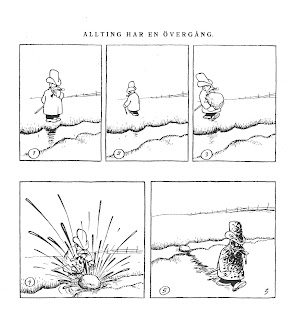In the late 19th century illustrated weeklies not only entertained their public with short gags, but they delivered also documentary graphic sequences - mostly about important events like disasters or political struggle. Also cultural events could get such a treatment. It is interesting to see how the same event was rendered in quite different ways.
In 1891, Richard Wagner's opera Siegfried was performed for the first time in Brussels (in De Munt/La Monnaie). A cultural event that the illustrated press of that period paid attention to. I compare two different approaches, each of which recreates four scenes from the opera in a different way.
One version is, according to the caption, by François Alexandre Alfred Gérardin (1841-1905) after sketches by Drot and was published in 1891 in the French weekly Le Monde Illustré.
The other version is by the Flemish artist Henri Cassiers (1858-1944) and appeared in 1891 in at least two Belgian illustrated weekly magazines (Illustration Européenne and Le Globe Illustré, the illustration used is from the first magazine).In terms of content, they choose almost the same scenes: Siegfried and Mine in the cave, Siegfried's fight with the dragon, the meeting with Brunnhilde (Cassiers chooses a moment earlier than Drot and Gérardin). One scene of the four chosen scenes is different: Gérardin opts for the scene with Erda, Cassiers for the fight with the Wanderer. Both scenes are from the third act.
Even more important is the arrangement of the scenes (panels) over the page. If we consider the Western reading pattern (from left to right, from top to bottom) there’s a remarkable difference. Drot and Gérardin place the scenes chronologically, according to their order in the opera. Cassiers, on the other hand, disrupts the chronology: it starts at the top left with the Brunnhilde scene from the third act, next the fight with the dragon from the second act, then the fight between Siegfried and the Wanderer from the third act, and ends at the bottom with a scene from the first act (Siegfried arrives in Mine's cave with the bear). We can only speculate as to why the story was rearranged this way. Perhaps Cassiers thought the idea of an underground rock fits better at the bottom of the page, while he places the scene with Brunnhilde on a higher rock (in the open air) at the very top of the page. In this way, Cassiers repeatedly makes an association between cave and a location below, between rock and a location above. Two different concepts of space (diegetic and composition of the page) are thus associated.
In terms of mise-en-scene, there are some correspondences. For instance, the organization of the dragon scene is partly similar: in each case, a large tree is at the front and fairly prominent in the picture, while the battle itself takes a smaller part of the panel and is placed at the background of scène. Of course, this mise-en-scène is largely dependent on the stage version, but an illustrator has still the freedom to frame the picture as he prefers: Cassiers put the tree a little more to the right, which delivers a better composition of the panel. He shows also much less leaves than this French colleagues. The black and white contrasts of Cassiers direct the eyes both to the tree and the fight scene. The French version has less such eyecatchers.
A big difference is thus the drawing style they use. With Drot and Gérardin it is a fairly clear performance, where everything is immediately recognizable. Whether it takes place in a cave or in the open air, everything remains easily identifiable. Cassiers, on the other hand, opts for atmosphere, mainly through chiaroscuro effects. The black and white contrasts make it all a lot more dramatic than Gérardin's good version. Recognizability is apparently less important with Cassiers, but the characters and locations remain recognizable. All in all, Cassier's version feels more Wagnerian.









